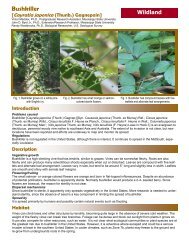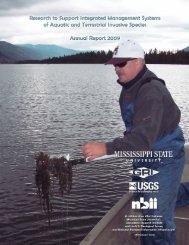Assessment of Herbicide Efficacy on Eurasian Watermilfoil and ...
Assessment of Herbicide Efficacy on Eurasian Watermilfoil and ...
Assessment of Herbicide Efficacy on Eurasian Watermilfoil and ...
Create successful ePaper yourself
Turn your PDF publications into a flip-book with our unique Google optimized e-Paper software.
Figure 3. <strong>Eurasian</strong> watermilfoil herbicide treatment areas <strong>on</strong> Hayden Lake,<br />
ID, 2007.<br />
for treating <strong>Eurasian</strong> watermilfoil. A paired-T test was used to<br />
assess differences in littoral native species richness <strong>and</strong> differences<br />
in native species richness for each herbicide between<br />
the pre- <strong>and</strong> post-treatment surveys (Statistix 8.0;<br />
Analytical S<str<strong>on</strong>g>of</str<strong>on</strong>g>tware 2003). All analyses were c<strong>on</strong>ducted at a p<br />
= 0.05 level <str<strong>on</strong>g>of</str<strong>on</strong>g> significance.<br />
Littoral Z<strong>on</strong>e Surveys<br />
8<br />
RESULTS AND DISCUSSION<br />
During the initial survey <str<strong>on</strong>g>of</str<strong>on</strong>g> Hayden Lake we observed 18<br />
different species <str<strong>on</strong>g>of</str<strong>on</strong>g> aquatic plants, with 17 species c<strong>on</strong>sidered<br />
native (Table 1). Wild celery ( Vallisneria americana Michx.)<br />
was c<strong>on</strong>sidered a native species for the purposes <str<strong>on</strong>g>of</str<strong>on</strong>g> our analyses,<br />
although there is debate as to whether this species is native<br />
to the Northwestern United States. The United States<br />
Department <str<strong>on</strong>g>of</str<strong>on</strong>g> Agriculture (USDA 2009) reports wild celery<br />
to be native to the lower 48 States. Crow <strong>and</strong> Hellquist<br />
(2000) report wild celery to be introduced to Washingt<strong>on</strong><br />
with no menti<strong>on</strong> <str<strong>on</strong>g>of</str<strong>on</strong>g> other western states. The littoral z<strong>on</strong>e<br />
was dominated by p<strong>on</strong>dweed ( Potamoget<strong>on</strong>)<br />
species, particularly<br />
Robbins’ p<strong>on</strong>dweed ( Potamoget<strong>on</strong> robbinsii Oakes) <strong>and</strong><br />
large-leaved p<strong>on</strong>dweed (Potamoget<strong>on</strong> amplifolius Tuckerm.).<br />
Robbins’ p<strong>on</strong>dweed had a frequency <str<strong>on</strong>g>of</str<strong>on</strong>g> occurrence <str<strong>on</strong>g>of</str<strong>on</strong>g> 52%<br />
<strong>and</strong> 66% for the early <strong>and</strong> late seas<strong>on</strong> surveys, respectively.<br />
Large-leaved p<strong>on</strong>dweed had a frequency <str<strong>on</strong>g>of</str<strong>on</strong>g> occurrence <str<strong>on</strong>g>of</str<strong>on</strong>g><br />
31% <strong>and</strong> 42% during this same time period.<br />
Native plant species richness increased (p < 0.01) from 1.5<br />
species per point during the early seas<strong>on</strong> survey to 2.1 species<br />
per point during the late seas<strong>on</strong> survey. We attribute some <str<strong>on</strong>g>of</str<strong>on</strong>g><br />
the increase in species richness to the seas<strong>on</strong>ality <str<strong>on</strong>g>of</str<strong>on</strong>g> native species,<br />
especially increases in the presence <str<strong>on</strong>g>of</str<strong>on</strong>g> some p<strong>on</strong>dweeds.<br />
P<strong>on</strong>dweeds are adapted to grow in low light envir<strong>on</strong>ments <strong>and</strong><br />
likely exp<strong>and</strong>ed into deeper water habitats as the growing seas<strong>on</strong><br />
progressed <strong>and</strong> temperatures increased, stimulating<br />
propagule germinati<strong>on</strong> <strong>and</strong> growth (Spence <strong>and</strong> Chrystal<br />
1970a, 1970b, Madsen <strong>and</strong> Adams 1989, Wersal et al. 2006b).<br />
Alternatively, <strong>Eurasian</strong> watermilfoil had a frequency <str<strong>on</strong>g>of</str<strong>on</strong>g> occurrence<br />
<str<strong>on</strong>g>of</str<strong>on</strong>g> 15% during the early seas<strong>on</strong> survey <strong>and</strong> was observed<br />
at




